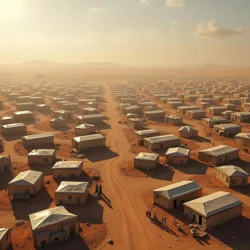The Grand Ethiopian Renaissance Dam Collapse of 2037 (continued)
Mass Population Displacement
The flood created the largest refugee crisis in human history, with an estimated 185 million people displaced across Northeast Africa. The Megadisaster Refugee Crisis protocols, developed after the Three Gorges Dam Catastrophe, proved wholly inadequate for managing population movements of this scale. Neighboring countries, including Libya, Chad, and Saudi Arabia, quickly closed their borders, leading to what the United Nations termed "death zones" along major escape routes.
The International Disaster Response Command estimated that secondary deaths from dehydration, starvation, and exposure in the weeks following the disaster exceeded 12 million. The destruction of transportation infrastructure and the widespread nuclear contamination severely hampered evacuation efforts, leaving millions stranded in increasingly uninhabitable areas.
 Aerial view of emergency refugee camps established in southern Libya, housing over 2 million displaced survivors
Aerial view of emergency refugee camps established in southern Libya, housing over 2 million displaced survivorsEnvironmental Impact
The environmental consequences of the GERD collapse extended far beyond the immediate flood zone. The combination of radioactive contamination and the sudden influx of freshwater into the Mediterranean Sea created what marine biologists termed the Mediterranean Ecological Collapse. The destruction of the Nile Delta, one of the world's most productive agricultural regions, eliminated approximately 6.7% of global rice production and 4.2% of global wheat production.
The nuclear contamination created a 1,200-kilometer-long zone of radioactive sediment along the former Nile Valley, which environmental scientists projected would remain dangerous for human habitation for several centuries. The Continental Toxic Plume from the disaster spread radioactive particles across much of North Africa and the Eastern Mediterranean, leading to increased cancer rates as far away as Southern Europe.
Global Economic Impact
Similar to the Three Gorges Dam Catastrophe of 2026, the GERD collapse triggered severe global economic disruptions. The destruction of the Suez Canal region and major Mediterranean ports created what economists termed the Second Supply Chain Crisis, with global shipping costs increasing by 312% within the first month. The loss of Egyptian and Sudanese agricultural production led to a worldwide food price crisis that particularly affected developing nations.
Global financial markets experienced what became known as the "Double Dam Shock," as fears of additional infrastructure failures led to massive selloffs in emerging market investments. The combined impact of the Three Gorges and GERD catastrophes fundamentally altered global approaches to infrastructure investment and risk assessment.
Geopolitical Transformation
The disaster completely reshaped the political landscape of Northeast Africa. Ethiopia, despite surviving as a political entity, faced international isolation and internal collapse following the revelation of its nuclear capability. The African Unity Coalition, formed in response to the crisis, effectively partitioned Ethiopia into administered zones to prevent further military actions.
The effective elimination of Egypt as a regional power created a geopolitical vacuum that dramatically altered Middle Eastern politics. The Post-Nile Power Structure that emerged saw the rise of a Libya-Chad-Saudi alliance that dominated North African affairs, while also accelerating the broader reorganization of global power structures that had begun with the Three Gorges disaster.
Impact on Global Infrastructure Policy
The GERD collapse, coming just eleven years after the Three Gorges disaster, led to the complete abandonment of mega-dam projects worldwide. The Global Infrastructure Safety Council, established in 2038, implemented mandatory decommissioning of all dams exceeding certain size and capacity thresholds. This policy shift fundamentally altered global approaches to energy and water management, accelerating the transition to distributed power generation and water management systems.
Scientific Advances
The unprecedented scale of the disaster spurred significant advances in nuclear decontamination technology and flood prediction modeling. The International Crisis Response Institute, building on lessons from both the Three Gorges and GERD catastrophes, developed new methodologies for managing cascading infrastructure failures. These advances would prove crucial in preventing several potential dam failures in subsequent years.
Long-Term Recovery Efforts
Recovery efforts in the affected regions continued for decades, though large portions of the Nile Valley remained uninhabitable due to nuclear contamination. The Global Rehabilitation Initiative, launched in 2040, focused on establishing new population centers in viable regions of former Sudan and Egypt, though these efforts were hampered by the complete destruction of traditional water management infrastructure.
Legacy
The GERD collapse, following so closely after the Three Gorges disaster, marked what historians term the "End of the Mega-Project Era." The catastrophe fundamentally altered humanity's approach to infrastructure development, water management, and nuclear security. The disaster's impact on global food production, shipping routes, and population distribution continued to influence world events well into the 22nd century.
See Also
- Three Gorges Dam Catastrophe of 2026
- Global Dam Safety Protocol
- International Crisis Response Institute
- Post-Three Gorges World Order
- Mediterranean Ecological Collapse
References
The extensive documentation of the disaster and its aftermath continues to inform global policy on infrastructure development, nuclear security, and disaster response. The combined lessons of the Three Gorges and GERD catastrophes remain central to international engineering education and disaster preparedness training.